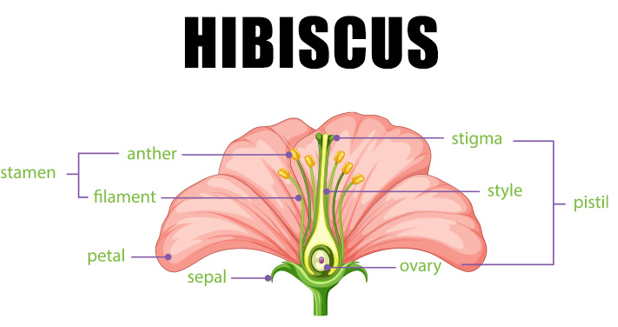
Hibiscus: Hibiscus, belonging to the genus Hibiscus, scientific name and family, comprises numerous species of shrubs, herbs, and trees within the mallow family. These plants are indigenous to warm temperate and tropical regions. Many species are grown for their attractive flowers, and some are cultivated for their fibre. Hibiscus plants are renowned for their large and striking flowers. They have been utilised for decorative and medicinal purposes for centuries. Extracts, teas, and supplements are derived from them. In traditional medicine, hibiscus preparations are employed to alleviate conditions like liver disorders and hypertension. The article details an important concept of hibiscus for the NEET Biology syllabus.
Flower – A Fascinating Organ of Angiosperms
Hibiscus Meaning
Hibiscus, also known as Roselle, is a member of the hibiscus family name Malvaceae family, which includes over 300 species of flowering plants. One of these species is Hibiscus sabdariffa Linne, which is valued for its potential health benefits. Hibiscus is a perennial plant that blooms all year and is cultivated in tropical and subtropical regions worldwide, including Africa, India, Sudan, China, Malaysia, and Taiwan.
Hibiscus is a large genus with several hundred species found in warm temperate, subtropical, and tropical regions worldwide. These plants are known for their large, colorful flowers and are commonly referred to as "hibiscus" or rose mallow. Other names for them include hardy hibiscus, rose of Sharon, and tropical hibiscus.
Hibiscus plants can be herbaceous or woody, including both annual and perennial varieties. The name "hibiscus" comes from the Greek word ἰβίσκος (ibískos), which Pedanius Dioscorides used to describe Althaea officinalis (c. 40–90 AD).
Several hibiscus species are popular as ornamental plants, including Hibiscus syriacus and Hibiscus rosa-sinensis. Hibiscus sabdariffa flower tea is popular around the world and can be served hot or cold. This tea is known for its bright red color, tart flavor, and high vitamin C content.
Sexual Reproduction in Flowering Plants MCQ for NEET
Hibiscus Diagram
The NEET biology diagrams, including the Hibiscus diagram, are provided as follows:

Pre-Fertilisation: Structures and Events
Hibiscus Common Name
The most frequently used name for Hibiscus is "hibiscus," yet various species of hibiscus have other common names. Some of these include:
- Chinese hibiscus or China rose (Hibiscus rosa-sinensis): This species is extensively cultivated and features large, vibrant flowers in a range of colours.
- Rose Mallow: A general term for hibiscus varieties resembling the mallow flower.
- Shoeblack Plant: This species (Hibiscus rosa-sinensis) was historically used to produce shoe polish.
- Hardy hibiscus (Hibiscus syriacus): A deciduous shrub native to eastern Asia, known for its large, showy flowers that bloom in late summer or early fall.
- Rose of Sharon: Another name for Hibiscus syriacus.
- Roselle (Hibiscus sabdariffa): Grown for its calyces, which are used to make a tangy beverage known as sorrel.
- Kenaf (Hibiscus cannabinus): Grown for its fibre, used in the production of rope, twine, and burlap.
Hibiscus Scientific Name
Hibiscus scientific name and family, Hibiscus, is the botanical or scientific name for the hibiscus genus of flowering plants that are commonly known as such. It belongs to the Malvaceae family, which includes mallow. The Hibiscus genus includes numerous species that can be found in warm temperate, subtropical, and tropical regions around the world. These species are well-known for their large, beautiful flowers.
Hibiscus Flower Plant
Hibiscus flower plants, known for their large and vibrant blooms, are a popular choice for gardens and landscapes. Here's some information about this beautiful hibiscus flower plant:
Scientific Name: Hibiscus
The hibiscus leaf scientific name refers to the leaves of species within the Hibiscus genus, which are typically ovate and glossy green, playing a key role in photosynthesis. The Hibiscus plant is a tropical shrub that can grow to a height of 15 feet. It has glossy green leaves and produces large trumpet-shaped flowers in a variety of colors, including red, pink, yellow, and white. The flowers can have single or double petals, and some varieties have a contrasting eye in the center.
Cultural Significance: Hibiscus flowers are not only visually appealing, but they also have cultural significance in many countries around the worThey are commonly used for ceremonies, decorations, and traditional medicine.ine.
Growing Conditions: Hibiscus plants thrive in warm climates and need plenty of sunlight to bloom profusely. They prefer well-drained soil with consistent watering. Pruning is essential for encouraging new growth and maintaining a bushy appearance.
Propagation: Hibiscus plants can be propagated using cuttings or seeds. Cuttings should be taken from healthy, mature plants and planted in a well-drained medium. Seeds can be planted directly in soil, but they may take longer to germinate.
Care and Maintenance: Fertilizing on a regular basis during the growing season promotes healthy growth and abundant flowering. Hibiscus plants are susceptible to pests such as aphids and spider mites, so they must be monitored on a regular basis and appropriate measures taken to control infestations.
Varieties: Hibiscus plants come in many different varieties, including the well-known Hibiscus rosa-sinensis, Hibiscus syriacus (Rose of Sharon), and Hibiscus sabdariffa (Roselle). Each variety has distinct characteristics and growth requirements.
The Hibiscus flower plant is an attractive and versatile addition to any garden or landscape. With proper care and maintenance, it will produce stunning blooms year after year.
Hibiscus Properties
The whole hibiscus plant, including its flower, stem, leaves, roots, and seeds, offers various health benefits:
- It may possess antiseptic properties, aiding in fighting infections.
- Hibiscus could have anti-spasmodic effects, helping to relieve muscle spasms.
- It may help lower blood pressure.
- The plant may act as a mild laxative, aiding in relieving constipation.
- Hibiscus might have diuretic effects, increasing urine production.
- It may exhibit antioxidant activity, protecting cells from damage.
- The plant could have anti-cancer properties, potentially inhibiting cancer growth.
- Hibiscus may have antipyretic effects, assisting in reducing fever.
- It might have sedative properties, promoting relaxation and sleep.
- The plant may help lower blood sugar levels.
Hibiscus Uses
The hibiscus plant offers a wide range of applications, both decorative and practical. Here is an overview of its common hibiscus uses:
Beverage: One of the most popular applications of hibiscus is in the form of a beverage. Hibiscus tea, also known as sorrel or karkade, is a rich red herbal tea made from the dried calyces (sepals) of the roselle hibiscus species. It has a tangy, cranberry-like taste and can be enjoyed either hot or cold. Hibiscus tea is believed to have numerous health benefits, such as reducing blood pressure and cholesterol levels.
Food:
- Food coloring: The vivid red hue of hibiscus flowers can serve as a natural food coloring in products like jams, jellies, and candies.
- Flavoring: The calyces of roselle hibiscus can also be utilised as a flavouring agent in jams, jellies, chutneys, and sauces due to their tangy flavour.
Medicine: Hibiscus has been used in traditional medicine for centuries to address various conditions, including:
- High blood pressure
- High cholesterol
- Upper respiratory infections
- Liver problems
- Stomach ulcers
Fiber: Fibers from the kenaf species of hibiscus can be fashioned into rope, twine, burlap, and even paper.
Hair care: Hibiscus leaves are at times, incorporated into hair care products for their perceived benefits in promoting hair growth and health.
Ornamental plant: Primarily, hibiscus is cultivated as an ornamental plant owing to its large, striking flowers that come in an array of colours. They can be cultivated as shrubs, trees, or even hedges.
| Other NEET Biology Topics | ||
|---|---|---|
| Ribosomes | Pollination | Apomixis |
| Centrosome | Embryo | Tissues |
Hibiscus Benefits
Hibiscus offers various potential health advantages, primarily because of its antioxidant content. Here is a breakdown of some key benefits:
- Blood Pressure Support: Research suggests that hibiscus tea may help reduce blood pressure, particularly for individuals with mild hypertension.
- Cholesterol Management: Some studies indicate that hibiscus could help lower bad (LDL) cholesterol levels and potentially raise good (HDL) cholesterol levels.
- Weight Management: Hibiscus might play a role in weight management, although further research is necessary. Some studies suggest it could modestly affect fat burning and reduce body fat mass.
- Antioxidant Properties: Hibiscus is rich in antioxidants, which can help combat cell damage and potentially lower the risk of chronic diseases such as heart disease and cancer.
- Antibacterial Effects: Test-tube studies suggest that hibiscus extract may have antibacterial properties, but more research is required to confirm its effectiveness against specific bacterial strains in humans.
It is important to note that most studies on the benefits of hibiscus are preliminary, and further research is ongoing. If you have any underlying health conditions, consult your doctor before consuming hibiscus tea or using hibiscus supplements.
Hibiscus in Hindi
हिबिस्कस फूल, जो अपनी जीवंत पंखुड़ियों और तुरही जैसी आकृति के लिए जाना जाता है, दुनिया भर के बगीचों में एक लोकप्रिय सजावटी पौधा है। इसकी सुंदरता इसके सांस्कृतिक महत्व से मेल खाती है, इस फूल का उपयोग अक्सर पारंपरिक चिकित्सा और अनुष्ठानों में किया जाता है। हिबिस्कस फूल प्रतीकात्मकता से समृद्ध है, जो कई संस्कृतियों में सुंदरता, यौवन और स्त्रीत्व का प्रतिनिधित्व करता है। इसकी पंखुड़ियाँ खाने योग्य होती हैं और इनका उपयोग चाय, जैम और सिरप बनाने के लिए किया जा सकता है, जिससे पाक कृतियों में फूलों का मनमोहक स्वाद और रंगों का तड़का लग जाता है।
NEET online coaching offers guidance from teachers and interactive sessions for effective learning. PW NEET Courses for Class 12 provide comprehensive study materials, practice tests, and past papers to enhance learning and exam readiness.
| NEET Exam Important Links | |
|---|---|
| NEET Syllabus | NEET Biology Diagrams |
| NEET Biology MCQ | NEET Biology Chapter wise Weightage |
| NEET Biology Notes | NEET Previous Year Question papers |
Hibiscus FAQs
What are the benefits of hibiscus?
What is hibiscus known for?
What are some medicinal uses of hibiscus?
Is hibiscus beneficial for hair?
What is the full name of hibiscus?
What is the scientific name of hibiscus?
What is hibiscus botanical name?










